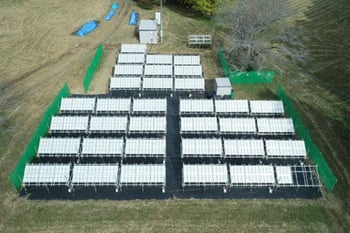PRESS RELEASE
- Research
- 2021
Photocatalytic solar hydrogen production from water on a 100m2-scale
Authors
Hiroshi Nishiyama, Taro Yamada, Mamiko Nakabayashi, Yoshiki Maehara, Masaharu Yamaguchi, Yasuko Kuromiya, Hiromasa Tokudome, Seiji Akiyama, Tomoaki Watanabe, Ryoichi Narushima, Sayuri Okunaka, Naoya Shibata, Tsuyoshi Takata, Takashi Hisatomi, Kazunari Domen
Abstract
The unprecedented impact of human activity on Earth’s climate and the ongoing increase in global energy demand have made the development of carbon-neutral energy sources ever more important. Hydrogen is an attractive and versatile energy carrier (and important and widely used chemical) obtainable from water through photocatalysis using sunlight, and through electrolysis driven by solar or wind energy1,2. The most efficient solar hydrogen production schemes, which couple solar cells to electrolysis systems, reach solar-to-hydrogen (STH) energy conversion efficiencies of 30% at a laboratory scale3. Photocatalytic water splitting reaches notably lower conversion efficiencies of only around 1%, but the system design is much simpler and cheaper and more amenable to scale-up1,2—provided the moist, stoichiometric hydrogen and oxygen product mixture can be handled safely in a field environment and the hydrogen recovered. Extending our earlier demonstration of a 1 m2 panel reactor system based on a modified, aluminium-doped strontium titanate particulate photocatalyst4, we here report safe operation of a 100 m2 array of panel reactors over several months with autonomous recovery of hydrogen from the moist gas product mixture using a commercial polyimide membrane5. The system, optimized for safety and durability and remaining undamaged upon intentional ignition of recovered hydrogen, reaches a maximum STH of 0.76%. While the hydrogen production is inefficient and energy negative overall, our findings demonstrate that safe, large-scale photocatalytic water splitting and gas collection and separation are possible. To make the technology economically viable and practically useful, essential next steps are reactor and process optimization to substantially reduce costs and improve STH efficiency, photocatalyst stability and gas separation efficiency.
Nature : https://www.nature.com/articles/s41586-021-03907-3

